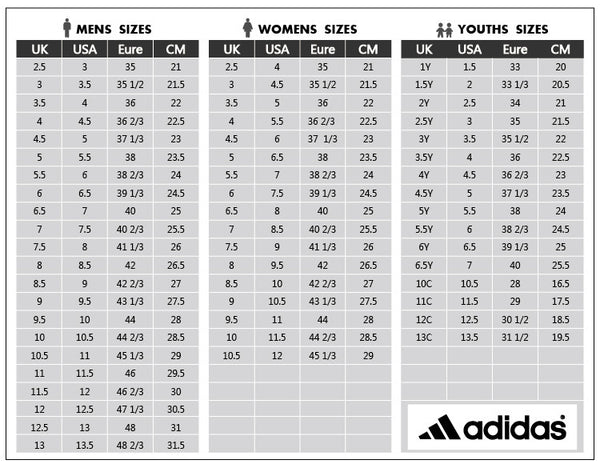Have you ever walked into a shoe store, grabbed a pair of sneakers that looked amazing, and then found out they were two sizes too big or too small? The frustration is real, especially when those sneakers are from iconic brands like Nike and Adidas. It’s like finding the perfect outfit, but the pants are just a tad too long. You might think, “Why does it always have to be so complicated?!”

Image: shoeeffect.com
The truth is, navigating shoe sizes can feel like a game of chance, especially with brands that might have slightly different sizing. But fret not! This guide will unravel the mysteries of Nike vs. Adidas shoe sizing so you can conquer the footwear aisle and find your perfect fit with confidence, no matter which brand you choose.
Understanding the Basics
Nike and Adidas are both renowned for their athletic footwear, but each brand has its own unique sizing system. Let’s break down the key differences to help you make informed choices.
Nike Sizing: Nike is known for its true-to-size fit. If you wear a size 10 in a regular shoe, you’ll likely find a size 10 Nike feels the same. However, there are a few exceptions to keep in mind. Some Nike styles, like the Air Max line, tend to run slightly larger, while others, such as the Air Force 1, might run slightly smaller.
Adidas Sizing: Adidas, on the other hand, tends to run a tad smaller than other brands. A size 10 Adidas might feel more like a size 9.5 in a regular shoe. This is particularly important to note for those with wider feet. Adidas shoes, especially their running shoes, are often considered to be narrower than Nike, so you might need to size up for a more comfortable fit.
The Importance of Trying On
Even with these general guidelines, there’s no substitute for trying on shoes before you buy them. Every foot is unique, and individual models and styles can vary significantly. Don’t be afraid to try on several sizes, and walk around the store to get a feel for how the shoe fits.
Factors that Can Affect Shoe Size
1. Your Foot Type:
- Foot Length: This is the most fundamental element of shoe sizing, and you can measure it with a ruler or tape measure. Always measure both feet, because one foot might be slightly longer than the other.
- Foot Width: Consider whether you have narrow, medium, or wide feet. Some shoe styles are inherently wider or narrower than others.
- Arch Height: A high arch can necessitate a shoe with more overall support, while a low arch might benefit from a shoe with a cushioned insole.
2. Shoe Style:
- Running Shoes: These shoes tend to be wider and longer to accommodate for the natural movement of your feet as you run.
- Basketball Shoes: They offer more ankle support and typically feature a narrower fit, offering stability during quick cuts and movements.
3. Material:
- Leather: Leather is a natural material that will stretch and mold to your foot over time, meaning a new pair of leather shoes might feel a bit tight at first.
- Synthetic Materials: These materials don’t stretch as much as leather, so you will often find that synthetic shoes fit closer to their actual size.
4. Personal Preferences:
- Fit: Do you prefer a snug fit, a roomy fit, or a more comfortable fit? Your personal preferences will also play a role in your ideal shoe size.
- Sock Thickness: Consider the thickness of the socks you intend to wear with your shoes, as this can affect the overall fit.

Image: donyaye-trade.com
Tips for Finding Your Perfect Fit
- Measure Your Feet: Start by taking accurate measurements of both feet. It’s best to do this at the end of the day when your feet are at their largest.
- Don’t Rely Solely on Size Charts: While size charts are a good starting point, always try on the shoe before you purchase it.
- Pay Attention to the Fit: How does the shoe feel when you put it on? Is it too snug, too loose, or just right? Pay attention to the overall comfort and stability, and be mindful of any pressure points that you notice.
- Walk Around: Don’t just stand in the shoe store. Walk around for a few minutes to see how the shoes feel when you’re moving.
- Size Up if Necessary: If you are between sizes, it’s always better to go up a half or full size, especially with sneakers.
- Don’t Be Afraid to Ask for Help: If you are having trouble finding the right size, don’t hesitate to ask a sales associate for assistance.
Nike Vs Adidas Shoe Size
Finding the Perfect Fit, No Matter the Brand
Navigating the world of shoe sizing can be a challenge, but it doesn’t have to be stressful. By understanding the nuances between Nike and Adidas sizes and applying the tips we’ve outlined, you’ll be on your way to finding the perfect fit for any occasion, whether you’re hitting the gym, hitting the streets, or simply hitting the couch.
And remember, the key to a comfortable and happy footwear experience is to choose a shoe that feels good on your feet. So, put on those sneakers, take a few steps, and let your feet guide you to a great fit.





